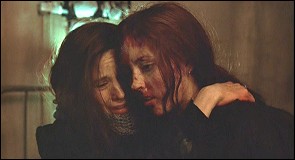![[Deep Focus]](../../flicker/longo.gif)

Cursed.
![[Deep Focus]](../../flicker/longo.gif)
|
|
| Ginger Snaps
|
|
 |
B+ |
|
Cursed. |
|
|
Movie Credits: Directed by John Fawcett
Written by Karen Walton Edited by Brett C. Sullivan Starring Emily Perkins and Katharine Isabelle Canada, 2000 Theatrical aspect ratio: 1.85:1
|
A gory coming-of-age tale that employs lycanthropy as a vicious metaphor for puberty, Canadian export Ginger Snaps manages to be the funniest werewolf movie since An American Werewolf in London and the darkest high-school movie since Heathers. Ginger Fitzgerald (Katharine Isabelle) and younger sister Brigitte (Emily Perkins) are high-school outcasts with a death fixation. In a nod to that phony-suicide classic, Harold and Maude, the girls are seen devising grisly modi operandi for their own demises-photographs of which form the basis for a classroom presentation that earns their teacher's scorn. The girls are of an age when sexual interests should be taking shape, but they still regard boys from a distance and with general distaste. Further, both of them are years late menstruating-when Ginger rubs her back at the dinner table, Mom (Mimi Rogers) wonders if she's finally getting her period. ("Maybe it's cancer of the spine," Ginger cracks sourly.) Because the two girls' best friends are each other, it makes sense that the arrival of Ginger's period-the girls call it "the curse"-would test their relationship. But Ginger's transformation is complicated by a werewolf attack that takes place as soon as she begins bleeding. She starts feeling sexually voracious, but it turns out that her hunger is of a more literal variety. And Brigitte is torn between anger and frustration at her sister's new interest in boys ("She's ovulating!" Brigitte yells at one suitor) and the sense that something terrible and inexplicable is happening to her. Key to Ginger Snaps' achievement is its impressive-for-a-werewolf-movie sense of the everyday. Director John Fawcett and screenwriter Karen Walton both hail from a television background, and they imbue the story with a keen sense of bizarre events slashing through the ordinary. Even as events begin to veer into horror-movie territory, Fawcett deals with them in matter-of-fact fashion-a nice touch is the tail that Ginger begins to grow, which she unfussily straps to her thigh with electrical tape. Brigitte eventually runs to the local pot dealer for ideas about a possible herbal antidote to her sister's condition. Ginger Snaps owes a great debt to horror traditions-not so much to George Waggner's original werewolf picture, The Wolf Man, as to director Jacques Tourneur's and producer Val Lewton's Cat People and especially the more-explicit Paul Schrader remake of that film. Brian De Palma's Carrie is another antecedent in the literal sense; thematically, though, Ginger Snaps is even closer to the body-horror cycle kicked off by (Canadian) filmmaker David Cronenberg in the late 1970s (especially his downright venereal Shivers and Rabid) and mainstreamed by Ridley Scott's Alien, itself fairly aghast at the particulars of reproductive processes. Here, Ginger herself is obviously disgusted at the changes being wrought on her body, and expresses her frustration not only by having sex-which in turn passes the "disease" on to the unlucky fella-but also by tearing living things into little pieces. Against the odds, you actually care what happens to this person. Fawcett and Walton have wisely constructed the film from the point of view of Brigitte, who grows increasingly agitated and desperate as Ginger's condition escalates. The close relationship between the Fitzgerald girls is sold by their relentlessly sullen snarkiness and by solid performances from the slumped-shouldered Perkins and nouveau-babish Perkins-she's an unusually good-looking wallflower as the story begins but begins wearing tight, come-hither clothing and slinks methodically through most of the film. Family life is surprisingly well represented, with Rogers as the sweetly well-meaning and not-entirely-clueless mother who eventually puts the pieces together herself. In fact, the movie takes no significant missteps until its very conclusion, when Isabelle is abruptly replaced by a special effect and the film swerves into more familiar territory. But never mind-the film's very last image is sufficiently haunting. Given a perfunctory U.S. theatrical release by Artisan Entertainment, the film is also available on a crappy Artisan DVD that not only displays copious compression artifacts, but also features the wrong aspect ratio and sound mix. The movie deserves better-like the new Canadian DVD, which sports an anamorphic widescreen transfer and features the film's Dolby Digital 5.1 sound mix as well as commentary from the film's writer and director and deleted scenes. If you're looking to make a purchase, try to track down the Canadian version.
|
 http://www.deep-focus.com/dfweblog/
bryant@deep-focus.com
http://www.deep-focus.com/dfweblog/
bryant@deep-focus.com